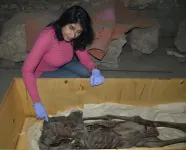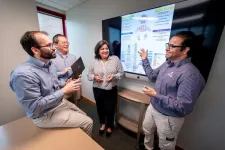(Press-News.org) In 1935, the Metropolitan Museum of New York led an archaeological expedition to Egypt. In Deir Elbahari near Luxor, the site of ancient Thebes, they excavated the tomb of Senmut, the architect and overseer of royal works – and reputedly, lover – of the famed queen Hatschepsut (1479-1458 BCE). Beneath Senmut's tomb, they found a separate burial chamber for his mother Hat-Nufer and other, unidentified relatives.
Here, they made an uncanny discovery: a wooden coffin holding the mummy of an elderly woman, wearing a black wig and two scarab rings in silver and gold. But what struck the archaeologists was the mummy's expression: with the mouth wide open, as if locked in a scream. They dubbed her the 'Screaming Woman'.
Now, approximately 2,500 years after her burial, researchers from Egypt have used the most advanced scientific techniques to examine the Screaming Woman and learn about her life and death. The results are published in Frontiers in Medicine.
Costly material
"Here we show that she was embalmed with costly, imported embalming material. This, and the mummy's well-preserved appearance, contradicts the traditional belief that a failure to remove her inner organs implied poor mummification," said Dr Sahar Saleem, a professor of radiology at Kasr Al Ainy Hospital of Cairo University.
Until 1998, the Screaming Woman had been kept at Kasr Al Ainy School of Medicine in Cairo, where in the 1920s and 1930s researchers studied many royal mummies, including Tutankhamun. Subsequently, she was moved to the Cairo Egyptian Museum at the request of the Ministry of Antiquities. Ever since 1935, the mummy’s coffin and rings have been displayed at the Metropolitan Museum of New York.
In the new study, Saleem used CT scans to ‘virtually dissect’ the mummy and estimate her age, identify pathologies, and state of preservation.
Saleem and her co-author Dr Samia El-Merghani also used advanced techniques like scanning electron microscopy (SEM), Fourier transform infrared spectroscopy (FTIR), and x-ray diffraction analysis (XRD) to identify the materials.
The authors found that the mummy was still in a good condition even 2,500 years after its burial. The investigation enacted 89 years after the discovery of the mummified woman shows her unwrapped, lying supine with her legs extended and her hands folded above the groin. She lacked several teeth – likely lost before death, as there was evidence of bone resorption, which occurs when a tooth comes out and the socket is left to heal. Other teeth were broken or showed signs of attrition.
“Teeth lost during life may have been extracted. Dentistry had originated in ancient Egypt, with Hesy Re the first recorded physician and dentist in the world,” said Saleem.
Suffered from arthritis
From 2D and 3D CT images, Saleem estimated that the Screaming Woman had been 1.54 meters tall in life. From the morphology of the joint between the two pelvic bones, which smoothens with age, the CT images estimated that she was approximately 48 years old at the time of her death. She had suffered from mild arthritis of the spine, as evident from the presence of osteophytes or ‘bone spurs’ on the vertebrae.
Saleem found no embalming incision, which was consistent with the discovery that the brain, diaphragm, heart, lungs, liver, spleen, kidneys, and intestine were still present. This was a surprise, as the classic method of mummification in the New Kingdom (1550–1069 BCE) included the removal of all such organs except the heart.
FTIR analysis of her skin showed that the Screaming Woman had been embalmed with juniper and frankincense, costly materials that had to be imported into Egypt from the Eastern Mediterranean and East Africa or Southern Arabia, respectively. Likewise, her natural hair had been dyed with henna and juniper. The long wig, made from fibers from the date palm, had further been treated with quartz, magnetite, and albite crystals, probably to stiffen the locks and give them the black color favored by ancient Egyptians because it represented youth.
“These findings support the ancient trade of embalming materials in ancient Egypt. The expedition led by Queen Hatshepsut brought frankincense from Punt (possibly Somalia in Africa). The tomb of Tutankhamun also contained frankincense and juniper,” said Saleem.
There was no obvious cause of death.
Cadaveric spam
But what had caused the mummy’s unforgettable expression? The rarity of the embalming material seemed to rule out that the mummification process had been careless and that the embalmers had simply neglected to close her mouth.
“The mummy's screaming facial expression in this study could be read as a cadaveric spasm, implying that the woman died screaming from agony or pain,” hypothesized Saleem.
Cadaveric spasm is a rare form of muscular stiffening, typically associated with violent deaths under extreme physical conditions and intense emotion.
“The Screaming Woman is a true ‘time capsule’ of the way that she died and was mummified,” concluded Saleem.
END
'Screaming Woman' mummy may have died in agony 3,500 years ago
Egyptian woman was embalmed with costly imported ingredients, suggesting her expression was caused by pain, not poor embalming
2024-08-02
ELSE PRESS RELEASES FROM THIS DATE:
Healthy AI: Sustainable artificial intelligence for healthcare
2024-08-02
Similar to other sectors around the world, the light speed development of artificial intelligence (AI) has made its way into healthcare, particularly the radiology field. As such, AI-based diagnostic systems are flourishing, with hospitals quickly adopting the technology to assist radiologists. In contrast, there are concerns about the environmental impact of increasingly complex AI models and the need for more sustainable AI solutions.
Therefore, Associate Professor Daiju Ueda of Osaka Metropolitan University’s ...
First full 2-D spectral image of aurora borealis from a hyperspectral camera
2024-08-02
Auroras are natural luminous phenomena caused by the interaction of electrons falling from the sky and the upper atmosphere. Most of the observed light consists of emission lines of neutral or ionized nitrogen and oxygen atoms and molecular emission bands, and the color is determined by the transition energy levels, molecular vibrations and rotations. There is a variety of characteristic colors of auroras, such as green and red, but there are multiple theories about the emission process by which they appear in different types of auroras, and to understand the colors of auroras, the light must be broken down. ...
Turkey vultures fly faster to defy thin air
2024-08-02
Mountain hikes are invigorating. Crisp air and clear views can refresh the soul, but thin air presents an additional challenge for high-altitude birds. ‘All else being equal, bird wings produce less lift in low density air’, says Jonathan Rader from the University of North Carolina (UNC) at Chapel Hill, USA, making it more difficult to remain aloft. Yet this doesn’t seem to put them off. Bar-headed geese, cranes and bar-tailed godwits have recorded altitude records of 6000 m and more. So how do they manage to take to the air when thin air offers ...
Texas A&M professor named to Committee on Rural Health by U.S. Secretary of Health and Human Services
2024-08-01
Dr. Alva O. Ferdinand, head of the Department of Health Policy and Management at the Texas A&M University School of Public Health, has been named to the Health Resources and Services Administration’s National Advisory Committee on Rural Health by U.S. Secretary of Health and Human Services Xavier Becerra. She will serve a four-year term on the committee, which is comprised of nationally recognized rural health experts tasked with providing recommendations on rural health issues.
Since 2019, Ferdinand has served as director of the Southwest Rural Health Research Center, whose research has impacted federal policies nationwide for more than two decades. ...
Drug developed for pancreatic cancer shows promise against most aggressive form of medulloblastoma
2024-08-01
A drug that was developed to treat pancreatic cancer has now been shown to increase symptom-free survival in preclinical medulloblastoma models – all without showing signs of toxicity.
Medulloblastoma is the most common malignant brain tumor in children. Survival rates vary according to which one of the four subtypes a patient has, but the worst survival rates, historically at about 40%, are for Group 3, which this research focused on.
Jezabel Rodriguez Blanco, Ph.D., an assistant professor who holds dual appointments at MUSC Hollings Cancer Center and the Darby Children’s ...
Retreat of tropical glaciers foreshadows changing climate's effect on the global ice
2024-08-01
MADISON — As they are in many places around the globe, glaciers perched high in the Andes Mountains are shrinking. Now, researchers at the University of Wisconsin–Madison and their collaborators have uncovered evidence that the high-altitude tropical ice fields are likely smaller than they've been at any time since the last ice age ended 11,700 years ago.
That would make the tropical Andes the first region in the world known to pass that threshold as a result of the steadily warming global climate. It also makes them possible harbingers of what's to come for glaciers globally.
"We think these are the canary ...
St. Jude gene panel for pediatric cancers increases access to high-quality testing
2024-08-01
Scientists at St. Jude Children’s Research Hospital have created a panel that is able to provide a diagnosis for >90% of pediatric cancer patients by sequencing 0.15% of the human genome. The panel is a cost-effective way to test and classify childhood malignancies and to help guide patient treatment. The panel’s performance and validation were published this week in Clinical Cancer Research.
Finding the mutations in a child’s cancer with powerful sequencing technology can lead to better outcomes. Physicians use that knowledge to tailor targeted treatments to the specific cancer-causing mutations affecting each patient. However, current ...
Health insurers have required prior authorization for services for decades—but have they treated patients equitably?
2024-08-01
Prior authorization—the process by which a health insurance company denies or approves coverage for a health care service before the service is performed—became standard practice beginning with Medicare and Medicaid legislation in the 1960s.
Although research has uncovered disparities in prior coverage for cancer patients based on race, little has been known to date on the role of prior authorization in increasing or decreasing these disparities.
To learn more about the issue, Benjamin Ukert, PhD, an assistant professor of health policy and management in the Texas A&M ...
Trying to limit calories? Skip the dip, researchers advise
2024-08-01
UNIVERSITY PARK, Pa. — Snacks provide, on average, about one-fourth of most people’s daily calories. With nearly one in three adults in the United States overweight and more than two in five with obesity, according to the National Institutes of Health, researchers in the Penn State Sensory Evaluation Center are investigating how Americans can snack smarter.
The latest study conducted in the center, housed in the College of Agricultural Sciences, investigated how eating behavior changes when consumers are served a dip with a salty snack. The findings, available online now and to be published in the November issue ...
Innovation Crossroads welcomes seven entrepreneurs for Cohort 2024
2024-08-01
Seven entrepreneurs comprise the next cohort of Innovation Crossroads, a Department of Energy Lab-Embedded Entrepreneurship Program node based at Oak Ridge National Laboratory. The program provides energy-related startup founders from across the nation with access to ORNL’s unique scientific resources and capabilities, as well as connect them with experts, mentors and networks to accelerate their efforts to take their world-changing ideas to the marketplace.
“Supporting the next generation of entrepreneurs is part of ORNL’s ...
LAST 30 PRESS RELEASES:
Ambitious model fails to explain near-death experiences, experts say
Multifaceted effects of inward foreign direct investment on new venture creation
Exploring mutations that spontaneously switch on a key brain cell receptor
Two-step genome editing enables the creation of full-length humanized mouse models
Pusan National University researchers develop light-activated tissue adhesive patch for rapid, watertight neurosurgical sealing
Study finds so-called super agers tend to have at least two key genetic advantages
Brain stimulation device cleared for ADHD in the US is overall safe but ineffective
Scientists discover natural ‘brake’ that could stop harmful inflammation
Tougher solid electrolyte advances long-sought lithium metal batteries
Experts provide policy roadmap to reduce dementia risk
New 3D imaging system could address limitations of MRI, CT and ultrasound
First-in-human drug trial lowers high blood fats
Decades of dredging are pushing the Dutch Western Scheldt Estuary beyond its ecological limits
A view into the innermost workings of life: First scanning electron microscope with nanomanipulator inaugurated in hesse at Goethe University
Simple method can enable early detection and prevention of chronic kidney disease
S-species-stimulated deep reconstruction of ultra-homogeneous CuS nanosheets for efficient HMF electrooxidation
Mechanical and corrosion behavior of additively manufactured NiTi shape memory alloys
New discovery rewrites the rules of antigen presentation
Researchers achieve chain-length control of fatty acid biosynthesis in yeast
Water interactions in molecular sieve catalysis: Framework evolution and reaction modulation
Shark biology breakthrough: Study tracks tiger sharks to Maui mating hub
Mysterious iron ‘bar’ discovered in famous nebula
World-first tool reduces harmful engagement with AI-generated explicit images
Learning about public consensus on climate change does little to boost people’s support for action, study shows
Sylvester Cancer Tip Sheet for January 2026
The Global Ocean Ship-Based Hydrographic Investigations Program (GO-SHIP) receives the Ocean Observing Team Award
Elva Escobar Briones selected for The Oceanography Society Mentoring Award
Why a life-threatening sedative is being prescribed more often for seniors
Findings suggest that certain medications for Type 2 diabetes reduce risk of dementia
UC Riverside scientists win 2025 Buchalter Cosmology Prize
[Press-News.org] 'Screaming Woman' mummy may have died in agony 3,500 years agoEgyptian woman was embalmed with costly imported ingredients, suggesting her expression was caused by pain, not poor embalming









